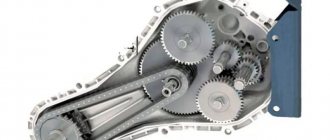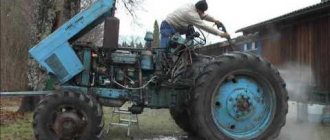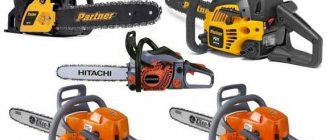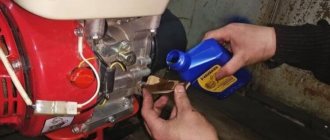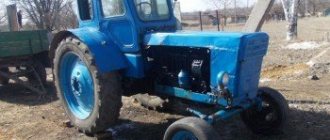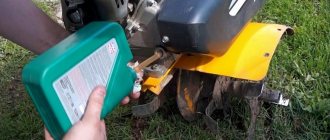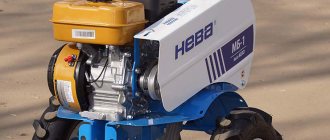Heavy snowfalls in winter are not only a joy for children, but also a difficult test for all public utilities. Engineers and designers were able to simplify the removal of snow mass by inventing auxiliary equipment called a snow blower. For long-term operation of the moving parts of such equipment, various lubricants and oils are required. It is important to determine which oil is best for a snow blower and whether it is possible to use car oil. When choosing, you need to take into account the requirements that will be placed on it due to abnormal conditions and low temperatures.
Oil requirements
Since the equipment will operate in a harsh, winter climate, any mechanical unit does not like an abundance of water and needs high-quality consumables. When choosing, the following requirements apply:
- The ability to use one type of oil for any engine, or more precisely, its versatility.
- Fluid service life. None of the potential users of winter equipment are interested in quickly changing the oil on a snow blower; everyone is interested in doing this as rarely as possible.
- High-quality oil has a high degree of lubrication of rubbing mechanisms, which directly affects the wear of parts and their further operation.
- Energy saving is also not the last indicator on this list. The better the oil, the higher its energy savings and minimal heat loss.
When choosing a liquid to be poured into a snow blower, you need to find out what type of engine is on the unit. There are usually 2 types of motors: two-stroke and four-stroke. Each of them has its own characteristics.
To operate a two-stroke engine, you need to fill it with gasoline mixed with oil in the recommended proportions. Then the pump pumps the mixture from the tank into a special tube and further into the cylinder. Suitable oils for such an engine are those that, when burned, will leave a minimal amount of soot.
In a four-stroke engine, a special system has been invented that allows you not to mix oil with gasoline. The four-stroke invention is considered more economical than the two-stroke one. It consists of a filter, a main pump and a valve. Here the oil has slightly different functions. They consist in stable preservation of motor performance throughout the entire service life of the mechanism. Different engine designs have also given rise to different choices of oils for them.
Try planting the very tasty Vorlon tomato variety; it has become my favorite.
On a note!
We should also not forget about diesel engines, which use diesel fuel instead of gasoline.
Types of motor oils for snow blowers
Before purchasing motor oil to service your snow blower engine, you need to select the appropriate oil composition.
There are 3 types in total:
- synthetic;
- mineral;
- semi-synthetic.
Of course, each type of lubricant has its own characteristics.
- Mineral oils. A natural product obtained by refining oil. Contains an impressive amount of sulfur. And sulfur provokes oxidative processes on the metal. To reduce the impact of sulfur, various additives, additives and synthetic substances are used. The advantage is low cost.
- Synthetic lubricants. They are completely artificial. At the same time, they have the best technical and operational characteristics. Synthetics are more economical, protect the engine better, and can be used in difficult climatic conditions. And even under extreme loads on equipment. There is actually only one minus. This is a high price.
- Semi-synthetic. Here, about 30% of the composition is synthetic substances and another 70% of mineral components. Combines the advantages of mineral and synthetic oils. Plus the price is average.
Oils are also divided into universal, winter and summer.
Since snow blowers are designed to clear areas of snow, this automatically implies operation only in winter. That is, you should fill it exclusively with winter or universal all-weather motor oils.
Types of lubrication
Nowadays, every major manufacturer that makes snowblowers mainly produces its own motor oil for snowblowers. Its use is recommended, but basically everyone simply obliges you to pour in a liquid produced by them, supposedly so that they do not void the warranty in case of engine failure. Basically, 3 types of liquid are widely used: mineral, synthetic and semi-synthetic.
Gasoline and fuel consumption
In order to understand which snow blower to choose, it is important to know its fuel consumption. It's worth noting that there are no specific meanings here. Consumption varies depending on engine power, area and topography of the treated area, height and density of snow, and the presence of ice. Ideally, the engine is 5.5 hp. consumes about 1 liter per hour of operation, models from 7 hp. spend about 2.5 liters. On average, this value is equal to 1.5-2 liters. The standard capacity of a gasoline tank is from 1.8 to 3 liters. Thus, on one refill the device can operate for 1.5 – 2 hours.
The best option for refueling a snow blower is gasoline with an octane rating of 92, in some cases 95 is used. Gasoline should be poured into the snow blower from a clean container. For a two-stroke engine, it is important to get the mixture right.
Advice! Before adding gasoline, you need to shake it. In addition, do not fill the container above the special mark.
Recommendations for selection
Oil for snowblowers is available in stores in an assortment. Here are a few examples that have proven themselves in Russian conditions:
- m-8 m is a mineral lubricant that is widely used in different countries of the world. Resistance to temperature changes and low wear of units.
- MT-16 R is poured into diesel engines. Excellent wear resistance of parts and metal oxidation.
- m-82 k is the most common type of mineral lubricant, intended for any engines. A pour point of -30 °C is achieved by using certain additives.
Universal lubricants are very popular today, as they are suitable for most types of engines. Representatives of such manufacturers are well-known domestic and foreign companies:
- RAVENOL Schneefraese 4-Takt 5W-30 is a well-known German brand that produces lubricants with such advantages as: low volatility and the ability to not even warm up the engine.
- Oregon SAE 30 is an American semi-synthetic lubricant used in gasoline snow blowers.
- Craftsman SAE 5W-30 is a Russian oil, suitable for all types of engines and is not inferior in quality to imported analogues.
One significant drawback of this product is its high price, which is not suitable for everyone. But, there are less “seasoned” brands, their products are practically in no way inferior to the giants. You can highlight , “Champion”, “Interskol”.
On a note!
You should not buy liquids that are suspicious; they are usually sold cheaply and thus lure ordinary buyers.
Tips and warnings
Tips and warnings
- Change the oil every 50 hours of operation and at the end of the season.
- The very first oil change should be done after 120 minutes of operation of the snow blower.
- If the engine is operating at maximum power, the oil must be changed more often than indicated.
- Remember to dispose of used oil. As stated above, drain the oil into the reservoir and take it to a service station.
- In order to prolong the operation of snow removal equipment, lubricate all parts that rotate or move with oil. Do not lubricate friction discs. Also add oil to the chute swivels that eject snow.
- To prepare the engine for storage, remove the spark plug and add about 20 ml of oil into the cylinder of the spark plug hole. Tighten the spark plug and smoothly turn the engine crankshaft so that the oil is evenly distributed inside.
- Also, before storing the engine, wipe its surface with a rag and lubricate it with a thin layer of oil to prevent rust on metal parts.
- If for some reason you want to submit your car for warranty repairs beforehand, leave a small amount of gasoline and do not drain a little. It is advisable to take with you the packaging of the oil that was used.
- Oil is also used to prevent metal parts from oxidizing.
- The oil level must be checked before starting the engine.
To summarize, it can be noted that correctly selected oil for the operation of this equipment is very important. The durability and serviceability of the engine system largely depends on it. It is also worth adhering to certain tips and warnings during operation, as they are very important for the normal functioning of the unit.
What to pour into the gearbox
The gearbox is the second mechanism after the motor and it is not recommended to neglect it. The stable operation of the gearbox depends on carefully selected casting material. Different manufacturers make gearboxes for thick and liquid lubricants. Anyone can determine what kind of lubricant to pour into the gearbox. If the snowplow is equipped with an oiler on the gearbox, then you need to use a viscous lubricant, pumping it there with a special syringe.
Snow blower gear oil - expert advice
Another important element that needs lubrication is the gearbox. Its elements are in constant interaction, which is why they are subject to constant wear and tear. Each specialist has his own opinion about what kind of oil to pour into the gearbox. However, all requirements for lubricant are reduced to a list of the most important parameters. These include:
- Inability to oxidize - the composition should not oxidize or degrade under the influence of cold temperatures and precipitation;
- Low consumption - motor oil for the gearbox must have a long service life so as not to change it too often;
- Short evaporation periods - the shorter the evaporation period, the less often you have to change the product;
- Slow wear under high loads - the oil must have optimal proportions of additives so as not to succumb to wear.
It is worth noting that more expensive snow blower gear oil has all of the above properties. But don’t be afraid of their prices - in practice, one can of high-quality product will cost an order of magnitude cheaper than several cans of cheap lubricants.
Is it possible to use a car
The question worries many car enthusiasts who do not want to deal with the search for certain lubricants. It can be said unequivocally that when car oil is poured into a snow blower, it cannot break, but it is also not worth recommending for long-term use. These oils have different properties and purposes. A car engine heats up to +95 degrees, and a snow blower engine can heat up to 120. The difference of more than 25% is very significant. This means that the viscosity of the automotive lubricant is not enough for a snow blower. If you urgently need to clear snow, and only use automotive oil, then the following conditions must be observed:
- every 30 minutes of work and one hour break;
- check the oil level using the dipstick;
- try not to overheat the engine.
Attention!
During long-term operation, it is necessary to change the automobile fluid more often, after 15 hours of operation.
Oil change interval
Once oil is poured into the engine of snow removal equipment, it cannot remain there forever, effectively performing all the functions assigned to the oil. Therefore, there is such a thing as snow blower engine maintenance, in which you need to drain the old fluid and fill in new one.
First, you should look at the product data sheet and instruction manual. Here the manufacturer is obliged to indicate which oil is optimal for the installed engine, as well as how often it needs to be changed.
If there is no such information in the documents, then one should doubt the quality of the equipment itself.
When for one reason or another it was not possible to find out the official recommendations, focus on the average values.
The recommendations here are as follows:
- On a new snow blower put into operation, the oil filled from the factory must be changed after 5 hours of operation. When the equipment has worked for these 5 hours in total, a replacement is carried out.
- The second and third replacements are also carried out at short intervals. On average this is from 5 to 10 hours of work.
- Subsequent replacements can be carried out at intervals of 50-55 hours. But provided that the snow blower operates stably and at standard load.
- If the air temperature is low and the density of the snow being removed is high, then it is better to change the engine oil after 35 operating hours.
It is important to drain the old fluid as much as possible and fill in new one. And this is only possible if the engine is preheated.
In general, there are several factors that also significantly affect how long the filled oil can effectively perform its tasks:
- the area of the territory that has to be cleared of snow;
- duration of continuous operation of the engine;
- terrain features of the site;
- volume and density of snow masses;
- the presence of a hard snow crust on the snow surface.
The more difficult the operating conditions, the more often it is recommended to change the oil. A similar principle applies when servicing cars.
How to fill correctly and how often
Snow blowers have 2 types of fill holes. The first side one is located on the side, where it is impossible to pour liquid without a watering can or funnel. But there is a plus: you won’t be able to overfill it, the oil will immediately start leaking out. The second hole from the top is more convenient to fill, but there is a chance of pouring a lot, and this is already harmful for the engine. Therefore, in order to correctly add liquid, several conditions must be met:
- Place the snow blower on a flat surface;
- find the filler bolt and unscrew it;
- Gently wipe the pouring area with a rag so that debris does not get inside;
- you need to pour slowly and check with a dipstick so as not to overdo it;
- close the tank with a lid and start the engine for a minute;
- Unscrew the cap and check, if there is insufficient supply, top up.
When purchasing a new unit, you need to run it in so that the parts gradually get used to each other. In winter, running-in usually lasts from 5-10 hours. After operating hours, the oil on the snow blower is changed. The old and all the rubbish must be drained, and the new must be filled in. Many manufacturers strongly advise using mineral oil during break-in. Synthetics do not allow parts to undergo full grinding.
Replacement instructions
Now directly to the question of changing the engine oil in a snow blower.
This is not to say that changing the oil is very difficult. Violation of basic rules and recommendations can lead to unpleasant consequences:
- if you drain a little of the old lubricant, a portion of fresh oil will not change anything much, and the engine will soon fail;
- a lack of fluid will lead to overheating and destruction of elements;
- Fill too much, oil will spill onto the spark plugs and cause starting problems.
To avoid all this, you need to know how to change and what kind of oil should be in your snow blower.
Determining how much oil is needed for the engine of a snow blower is not difficult. It is best to find out information from your passport data. Or follow the simple principle - as much as you drain, you fill in as much. Only here you also need to take into account that there could be little or too much oil in the system.
Having determined the type, brand and volume of oil for your snow blower, you can begin to change the engine oil. To do this you need to do the following:
- place the snow blower on a flat horizontal surface;
- start the engine;
- let the engine run for a few minutes to warm up the oil;
- turn off the engine;
- prepare a container of the required volume into which the waste will be drained;
- open the drain hole by placing a container under it;
- wait until the lubricant flows out completely;
- close the drain hole;
- unscrew the filler cap and dipstick on the neck;
- carefully pour in a new portion of lubricant;
- start the engine and let it run for a few minutes;
- use a dipstick to check the current level.
If there is not enough oil, which is clearly indicated by the dipstick, then add a little more. If there is excess liquid, it can be drained through the drain hole, or pumped out using a syringe and a long tube attached to the end. Moreover, the second option is preferable, since the volume can be precisely controlled.
Tips for use
It is important to use equipment regularly and maintain it on time. It is best to remove freshly fallen snow, not in large quantities. If the cover is already deep, but recently formed, then you need to work with the unit slowly. With compacted snow, movements should be even slower, no more than 30 cm at a time. This will reduce the load on the gearbox. Don’t forget about safety precautions: wear non-slip shoes and work in good visibility.
To make your life easier in winter and purchase a quality snow blower, you need to immediately determine what price suits you, how long it will work, whether you need to pay for the brand or buy a Chinese clone. You should not take a very cheap one, made somewhere in the basement, which costs a penny and will fall apart very soon. But it also seems stupid to pay for the name of a well-known company. You need to choose a middle ground.
With a good snow blower, snow removal will turn from hard, physical, monotonous work into a pleasant, easy winter walk in the fresh air. You should never waste money on equipment, as you will have to spend much more on your health later.
Two-stroke and four-stroke engines
Internal combustion engines are divided into two types:
- two-stroke;
- four-stroke.
One stroke is the movement of the piston up or down. One revolution of the shaft requires two strokes. Engines in which one shaft revolution occurs per operating cycle are called two-stroke. Models with two revolutions are four-stroke. The differences between these engines lie not only in design, but also in some other indicators. In particular, there is a difference in the method of lubrication.
In a two-stroke engine, lubrication is carried out using a mixture obtained by combining oil and gasoline in a ratio of 1:25 or 1:50. The mixture circulates in the system and lubricates all necessary components. After it ignites, the oil is eliminated in the form of combustion products. There are two ways to get the mixture. In the first case, this is carried out directly by the operator, that is, a ready-made version is uploaded. In the second, the technology does everything itself. In this case, the engine is equipped with a special oil tank, from which, using a pump, oil in a strictly specified amount enters the nozzle, where mixing is carried out.
Four-stroke engines do not require mixture. Oil and fuel enter the system separately. In this case, the engine has a special lubrication system, which includes a pump, filters, valve and oil supply line.
Due to the fact that two-stroke engines burn oil, but 4-stroke engines do not, the oil requirements for both systems differ. In the first case, it must produce as few products as possible during combustion, in the second, it must maintain its characteristics for a long time.

